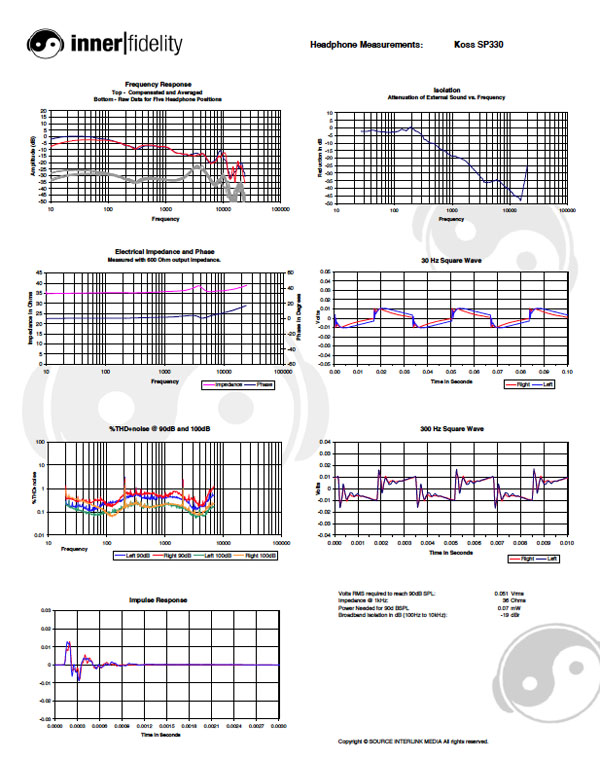| Columns Retired Columns & Blogs |
A Sonic Stunner: The Koss SP330 On-Ear Headphone Measurements
Click on graphs image to download .pdf for closer inspection.
Raw frequency response measurements show an ear pad that varies some with bass placement. In listening tests it became apparent that the actual ability to seal and deliver bass response was much worse in real listening situations. (I guess I try to be careful when taking the measurements. I think it would be very difficult to have the goal to recreate real-world listening performance when positioning the headphones, as opposed to trying for best seal in each position.) If these headphones don't seal reasonably well, bass response is compromised.
Compensated FR plots, other than a few modest bumps and wiggles, seems very, very good to me. A nice bass rise with good extension. Bass rise appears to start at 300Hz, which is a bit high, but compared to the level between 400Hz to 1kHz, you could say the bass rise starts at 200Hz. I like 150Hz, so that's close, but the truth is because of the likelihood of somewhat poor coupling you are likely to get less bass that what is measured.
Compensated response from 400Hz to 4kHz might be considered spectacular. Almost all headphones tend to fall off in this region, the SP330 is essentially flat to 4.5kHz. In listening, this made them sound very present, first row seating. Normally I'd be wary of that as things might get strident, but I didn't hear that. They were just strongly present—lacking in any sense of veil.
The only problem area is the mid- and upper-treble where we see two distinct bumps at 10Khz and 20kHz. I did tend to hear treble transients as just a little metallic, but that's not quite the right word.
A glance at the 300Hz square wave shows what might be the origin of the slightly off treble, slightly excessive undershoot after the first spike. I've mentioned it before, a very clean and regular ring on the front end of the 300Hz square wave is often quite benign. In listening, though cymbals were accentuated a bit, they remained remarkably clear and natural sounding.
30 Hz square wave response is near ideal with small shoulder on the leading edge and a long, straight, waveform top following. Looking at the THD in the bass shows an unbelievably low amount of distortion for a headphone of this type.
Speaking of distortion, the THD+noise plot is very, very good for an on-ear headphone. Not only is the bass distortion almost unbelievably low, but all measurements are below 1%, and the 100dB curve remains below the 90dB curve for almost its entire length. This is a clean sounding headphone, and it will play clean even at loud levels.
Impulse response leading edge is quick, but a couple of resonances mar the immediately following response. Fortunately, these problems die rather quickly.
Impedance and phase plots show a well behaved 35 Ohm headphone.
Isolation is remarkably good at 19dB broad band—I have to think, however, that in real-world use the seal will be significantly less effective.
With an efficiency of 51mVrms the SP330 will play to solid listening levels on portable devices.
- Log in or register to post comments





































